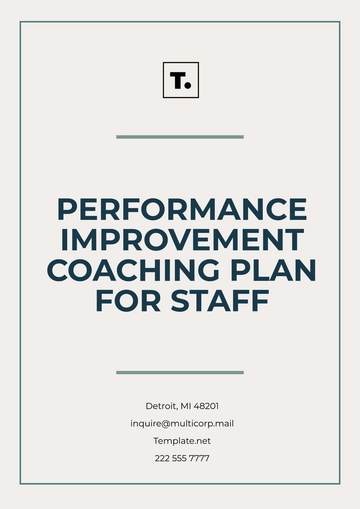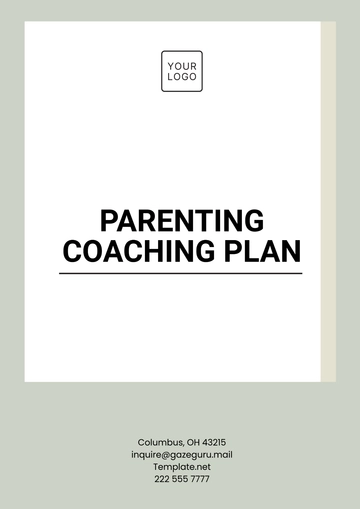Free Retirement Planning Coaching Plan

Prepared by: [Your Name]
Date: [Date]
I. Introduction
Retirement planning is a critical component of financial security, and coaching can help individuals navigate the complexities of preparing for retirement. This coaching plan aims to provide a structured approach to ensuring clients achieve their retirement goals. It includes a mix of education, action steps, and support to make informed decisions and create a sustainable retirement plan.
II. Goal Setting and Financial Assessment
A. Define Retirement Goals
Discuss the client’s ideal retirement lifestyle (e.g., travel, hobbies, family time).
Set a target retirement age and desired retirement income.
B. Current Financial Situation Review
Assess income, savings, investments, debts, and assets.
Identify existing retirement savings (401(k), IRAs, pensions, etc.).
C. Retirement Income Needs Calculation
Estimate future living expenses.
Adjust for inflation and anticipated health care costs.
III. Investment Strategy
A. Risk Tolerance Evaluation
Conduct surveys or discussions to assess comfort with investment risk.
Determine an appropriate asset allocation strategy.
B. Portfolio Diversification
Develop a diversified portfolio based on risk tolerance and retirement timeline.
Include a mix of stocks, bonds, mutual funds, and alternative investments.
C. Tax-Efficient Investment Strategies
Educate on tax-deferred and tax-free retirement accounts (e.g., Roth IRAs).
Maximize tax advantages with tax-efficient investment choices.
IV. Retirement Savings Plan
A. Create a Savings Strategy
Set monthly or annual savings goals to meet retirement targets.
Recommend increasing contributions over time, especially with employer-sponsored plans.
B. Maximize Employer-Sponsored Retirement Plans
Encourage the client to take full advantage of employer matches (if available).
Evaluate the benefits of additional contributions to these plans.
C. Supplementary Savings and Investments
Recommend opening additional retirement accounts (e.g., IRAs, brokerage accounts).
Explore other investment opportunities like real estate or annuities.
V. Debt Management and Minimization
A. Prioritize Debt Repayment
Help create a plan to pay off high-interest debt (credit cards, personal loans).
Discuss debt repayment strategies (debt snowball vs. debt avalanche).
B. Mortgage Considerations
Evaluate whether paying off a mortgage before retirement is advantageous.
Discuss options such as downsizing or refinancing to reduce monthly expenses.
VI. Healthcare and Long-Term Care Planning
A. Understand Healthcare Needs in Retirement
Discuss Medicare eligibility and options.
Review the costs associated with health care in retirement.
B. Plan for Long-Term Care
Explore long-term care insurance options.
Discuss potential home health care or assisted living needs.
VII. Social Security and Pension Planning
A. Optimize Social Security Benefits
Analyze the best time to start taking Social Security benefits.
Educate on spousal benefits and survivor benefits.
B. Pension Plans and Annuities
Review any pensions or annuities and their payout options.
Ensure understanding of how these will contribute to retirement income.
VIII. Estate Planning
A. Will and Trust Preparation
Discuss the importance of creating a will and/or trust.
Ensure beneficiaries are up to date on all accounts and assets.
B. Power of Attorney and Healthcare Directives
Educate on setting up powers of attorney for financial and healthcare decisions.
Ensure a living will is in place to reflect end-of-life wishes.
IX. Regular Review and Adjustments
A. Annual Retirement Plan Review
Set up regular check-ins to assess progress toward retirement goals.
Adjust the plan as necessary based on changes in income, market conditions, or life circumstances.
B. Account Rebalancing and Strategy Adjustments
Reassess portfolio allocations and rebalance as necessary.
Update savings targets, income goals, or retirement dates if needed.
X. Conclusion
A well-structured retirement plan provides peace of mind and financial security in retirement. Through ongoing coaching and adjustments, clients can confidently move toward achieving their retirement dreams while remaining flexible in response to changing needs and circumstances.
- 100% Customizable, free editor
- Access 1 Million+ Templates, photo’s & graphics
- Download or share as a template
- Click and replace photos, graphics, text, backgrounds
- Resize, crop, AI write & more
- Access advanced editor
Prepare clients for a secure future with the Retirement Planning Coaching Plan Template from Template.net. This editable and customizable template helps coaches design personalized retirement plans, focusing on savings, investments, and post-retirement goals. Easily edit the template using our Ai Editor Tool to tailor it to each client’s financial situation and timeline. Equip your clients with the tools they need to enjoy a comfortable retirement.
You may also like
- Finance Plan
- Construction Plan
- Sales Plan
- Development Plan
- Career Plan
- Budget Plan
- HR Plan
- Education Plan
- Transition Plan
- Work Plan
- Training Plan
- Communication Plan
- Operation Plan
- Health And Safety Plan
- Strategy Plan
- Professional Development Plan
- Advertising Plan
- Risk Management Plan
- Restaurant Plan
- School Plan
- Nursing Home Patient Care Plan
- Nursing Care Plan
- Plan Event
- Startup Plan
- Social Media Plan
- Staffing Plan
- Annual Plan
- Content Plan
- Payment Plan
- Implementation Plan
- Hotel Plan
- Workout Plan
- Accounting Plan
- Campaign Plan
- Essay Plan
- 30 60 90 Day Plan
- Research Plan
- Recruitment Plan
- 90 Day Plan
- Quarterly Plan
- Emergency Plan
- 5 Year Plan
- Gym Plan
- Personal Plan
- IT and Software Plan
- Treatment Plan
- Real Estate Plan
- Law Firm Plan
- Healthcare Plan
- Improvement Plan
- Media Plan
- 5 Year Business Plan
- Learning Plan
- Marketing Campaign Plan
- Travel Agency Plan
- Cleaning Services Plan
- Interior Design Plan
- Performance Plan
- PR Plan
- Birth Plan
- Life Plan
- SEO Plan
- Disaster Recovery Plan
- Continuity Plan
- Launch Plan
- Legal Plan
- Behavior Plan
- Performance Improvement Plan
- Salon Plan
- Security Plan
- Security Management Plan
- Employee Development Plan
- Quality Plan
- Service Improvement Plan
- Growth Plan
- Incident Response Plan
- Basketball Plan
- Emergency Action Plan
- Product Launch Plan
- Spa Plan
- Employee Training Plan
- Data Analysis Plan
- Employee Action Plan
- Territory Plan
- Audit Plan
- Classroom Plan
- Activity Plan
- Parenting Plan
- Care Plan
- Project Execution Plan
- Exercise Plan
- Internship Plan
- Software Development Plan
- Continuous Improvement Plan
- Leave Plan
- 90 Day Sales Plan
- Advertising Agency Plan
- Employee Transition Plan
- Smart Action Plan
- Workplace Safety Plan
- Behavior Change Plan
- Contingency Plan
- Continuity of Operations Plan
- Health Plan
- Quality Control Plan
- Self Plan
- Sports Development Plan
- Change Management Plan
- Ecommerce Plan
- Personal Financial Plan
- Process Improvement Plan
- 30-60-90 Day Sales Plan
- Crisis Management Plan
- Engagement Plan
- Execution Plan
- Pandemic Plan
- Quality Assurance Plan
- Service Continuity Plan
- Agile Project Plan
- Fundraising Plan
- Job Transition Plan
- Asset Maintenance Plan
- Maintenance Plan
- Software Test Plan
- Staff Training and Development Plan
- 3 Year Plan
- Brand Activation Plan
- Release Plan
- Resource Plan
- Risk Mitigation Plan
- Teacher Plan
- 30 60 90 Day Plan for New Manager
- Food Safety Plan
- Food Truck Plan
- Hiring Plan
- Quality Management Plan
- Wellness Plan
- Behavior Intervention Plan
- Bonus Plan
- Investment Plan
- Maternity Leave Plan
- Pandemic Response Plan
- Succession Planning
- Coaching Plan
- Configuration Management Plan
- Remote Work Plan
- Self Care Plan
- Teaching Plan
- 100-Day Plan
- HACCP Plan
- Student Plan
- Sustainability Plan
- 30 60 90 Day Plan for Interview
- Access Plan
- Site Specific Safety Plan





























